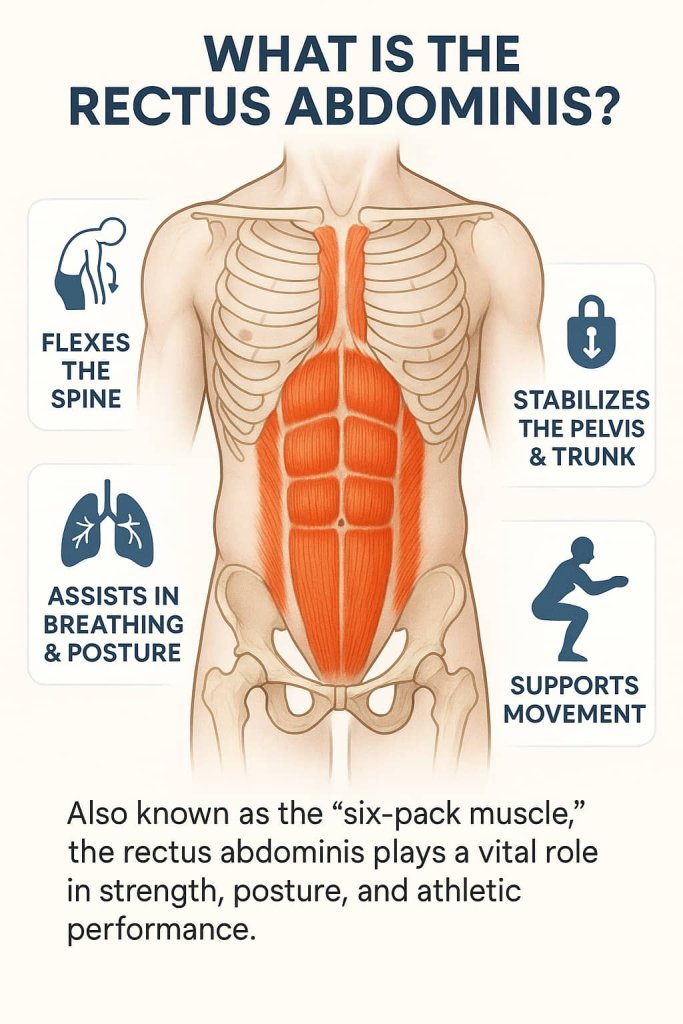The best way to strengthen your rectus abdominis — the “six-pack” muscle — is by combining controlled, resistance-based, and stability-focused movements.
This muscle group runs vertically along your abdomen and plays a crucial role in posture, spinal support, and athletic performance.

Building it isn’t just about crunches — new research highlights the power of functional and multi-joint exercises that target the rectus abdominis more effectively.
In this guide, you’ll learn the top 10 proven exercises, how to perform them safely, and science-based tips to sculpt a stronger, more defined core.
What Is the Rectus Abdominis?
The rectus abdominis is a long, flat muscle that runs from the ribs down to the pubic bone.
It’s divided by tendinous intersections — creating the familiar “six-pack” look.

Main Functions:
- Flexes the spine (bends your torso forward)
- Stabilizes the pelvis and trunk
- Assists in breathing and posture
- Supports movements like squats, pushups, and running
When properly trained, this muscle not only enhances appearance but reduces lower back pain and improves core stability — vital for strength, balance, and injury prevention.
10 Best Rectus Abdominis Workouts
Each exercise below includes why it works, muscles worked, how to do it (in bullet steps), and a trainer tip to maximize results.
1. Ab Wheel Rollout
Why it works:
This advanced core move ranks among the most effective exercises for rectus abdominis activation. It challenges your abs through an extended range of motion, training both strength and anti-extension stability — crucial for athletic performance.
Muscles worked:
Rectus abdominis, transverse abdominis, obliques, latissimus dorsi, deltoids, spinal stabilizers.
How to do it:
- Kneel on a mat with an ab wheel in front of you.
- Engage your core and roll the wheel forward slowly and smoothly, extending your body as far as your control allows.
- Pause briefly when your arms are extended and your torso is parallel to the floor.
- Roll back to the starting position using your abs, not your lower back.
Trainer Tip:
Start with shorter rollouts and gradually increase distance. Keep your back flat — if it arches, you’ve gone too far.
2. Hanging Knee Raise
Why it works:
Uses bodyweight resistance and gravity to target the lower portion of the rectus abdominis, which is often the hardest to define. It also improves grip and core control.
Muscles worked:
Rectus abdominis (lower), hip flexors, obliques, forearms.
How to do it:
- Hang from a pull-up bar with an overhand grip.
- Keep your body still and lift your knees toward your chest while exhaling.
- Hold for 1 second at the top, then lower slowly.
Trainer Tip:
Avoid swinging or using momentum. Once you’re comfortable, progress to straight-leg raises for more intensity.
3. Reverse Crunch
Why it works:
Minimizes lower-back strain while deeply engaging the lower rectus abdominis. Perfect for building core strength safely.
Muscles worked:
Rectus abdominis (lower), transverse abdominis, hip flexors.
How to do it:
- Lie flat with your arms by your sides and legs bent at 90°.
- Curl your hips off the mat, bringing knees toward your chest.
- Slowly lower back down, keeping tension in your core.
Trainer Tip:
Think of rolling your spine off the floor instead of lifting your legs. Control is everything — no jerking.
4. Cable Crunch
Why it works:
Provides progressive overload for your abs — crucial for muscle growth and definition. The cable’s constant tension makes every rep effective.
Muscles worked:
Rectus abdominis (upper and middle), obliques.
How to do it:
- Attach a rope handle to a high pulley.
- Kneel below the pulley, hold the rope beside your ears.
- Flex your spine to bring your elbows toward your knees.
- Slowly return to the start without relaxing your abs.
Trainer Tip:
Focus on spinal flexion, not hip movement. Keep your hips locked in place throughout the movement.
5. Stability Ball Pike
Why it works:
A dynamic full-core exercise that demands balance, coordination, and strength. It targets both the upper and lower rectus abdominis while engaging shoulders and lats.
Muscles worked:
Rectus abdominis, deltoids, hip flexors, transverse abdominis.
How to do it:
- Begin in a plank with your feet on a stability ball.
- Keeping legs straight, lift hips toward the ceiling into a “pike” shape.
- Pause, then lower back to plank with control.
Trainer Tip:
Don’t rush — move slowly and smoothly. Fast reps shift tension off the abs and into the shoulders.
6. Weighted Decline Sit-Up
Why it works:
By working against gravity on a decline, this move emphasizes upper rectus abdominis strength and creates visible definition when combined with a calorie deficit.
Muscles worked:
Rectus abdominis (upper), hip flexors, internal obliques.
How to do it:
- Secure your feet on a decline bench.
- Hold a weight plate or dumbbell against your chest.
- Sit up until your torso is vertical.
- Lower back down under control, keeping tension constant.
Trainer Tip:
Avoid pulling with your arms or jerking upward — focus on slow, full-range motion for maximum tension.
7. Lying Leg Raise
Why it works:
A 2023 MDPI study showed that leg raises activate the lower abs more effectively than most planking variations. Excellent for lower-core strength and tone.
Muscles worked:
Rectus abdominis (lower), hip flexors, transverse abdominis.
How to do it:
- Lie on your back, arms at sides or under hips.
- Keep legs straight and lift them until perpendicular to the floor.
- Lower slowly until just above the ground — don’t touch the floor.
Trainer Tip:
Keep your lower back pressed into the mat the entire time to prevent strain and ensure full ab activation.
8. Forearm Plank
Why it works:
A foundational anti-extension exercise that builds deep core endurance, teaching your body to resist movement — the essence of functional strength.
Muscles worked:
Rectus abdominis, transverse abdominis, glutes, deltoids.
How to do it:
- Lie face down and prop yourself on forearms and toes.
- Maintain a straight line from head to heels.
- Engage your core and hold for 30–60 seconds.
Trainer Tip:
Imagine pulling your elbows toward your toes — this “tension trick” increases ab engagement instantly.
9. V-Up
Why it works:
A dynamic, gymnastic-style move that trains upper and lower abs together, improving core coordination and explosiveness.
Muscles worked:
Rectus abdominis (entire length), hip flexors.
How to do it:
- Lie flat with arms extended overhead.
- Simultaneously lift your legs and upper body, reaching hands toward toes.
- Lower under control to avoid swinging.
Trainer Tip:
Exhale during the lift — this naturally contracts your abs harder and protects your lower back.
10. Standing Cable Woodchop
Why it works:
Combines rotation and flexion, making it a functional core movement that targets the rectus abdominis, obliques, and transverse abs together.
Muscles worked:
Rectus abdominis, obliques, transverse abdominis, shoulders.
How to do it:
- Attach a handle to a cable machine at shoulder height.
- Stand sideways and pull the handle diagonally across your body.
- Return slowly to the start, resisting rotation.
Trainer Tip:
Drive the motion from your core, not your arms. Keep your abs braced and move in a controlled diagonal path.
Sample Rectus Abdominis Workout Plan
| Level | Focus | Sets x Reps | Frequency |
|---|---|---|---|
| Beginner | Form & stability | 3×10–12 | 2–3× per week |
| Intermediate | Strength & definition | 4×12–15 | 3–4× per week |
| Advanced | Power & endurance | 4–5×10–20 | 4–5× per week |
✅ Trainer Tip:
Combine 2 upper-ab + 2 lower-ab + 1 stability exercise for a balanced core routine.
Safety Tips and Modifications
- Warm up with dynamic stretches or light planks.
- Avoid excessive spinal flexion (limit full sit-ups if you have back issues).
- Engage your core — never let your belly “sag.”
- Progress gradually with added resistance.
- Prioritize control over speed.
Benefits of a Strong Rectus Abdominis
- Improved posture and spinal stability
- Reduced lower back pain
- Enhanced sports performance
- Visible abdominal definition
- Better overall body balance and coordination
FAQs
1. How often should I train the rectus abdominis?
2–4 times per week is ideal for strength and recovery balance.
2. Do I need weights for ab definition?
Not necessarily — bodyweight is enough, but resistance adds growth stimulus.
3. How long does it take to see visible abs?
Typically 8–12 weeks with consistent training and clean nutrition.
4. Are crunches enough to build abs?
They help, but full development needs varied angles (planks, rollouts, leg raises).
5. What’s the best lower ab exercise?
Reverse crunches and leg raises are top choices for the lower rectus abdominis.
6. Can I train abs every day?
You can do light stability work daily, but allow rest between intense sessions.
Conclusion
To build a strong, defined core, train your rectus abdominis through both resistance and stability-based exercises.
Mix movements like ab wheel rollouts, leg raises, planks, and cable crunches for maximum results.
Consistency, progressive overload, and proper form are the keys to visible, functional abs.
👉 Start today — 10–15 minutes of focused ab work, 3–4 times per week, can completely transform your core strength.
References
- JOSPT (2010) — Core Muscle Activation During Swiss Ball and Traditional Abdominal Exercises
Findings: Roll-out and pike produced some of the highest rectus abdominis activations among tested exercises.
Link: https://www.jospt.org/doi/10.2519/jospt.2010.3073 - IJERPH (2020) — Systematic Review of Core Muscle Activity During Fitness Exercises
Findings: Across 67 studies, free-weight/instability tasks frequently elicited greater RA activation; exercise selection should match stability vs. flexion goals.
Link: https://www.mdpi.com/1660-4601/17/12/4306 (open-access) - Journal of Back and Musculoskeletal Rehabilitation (2019) — Plank vs. Bilateral Leg Raise
Findings: Bilateral leg raises showed significantly greater rectus abdominis activation than the plank (p < 0.05).
Link: https://pubmed.ncbi.nlm.nih.gov/30856100/ - Journal of Sports Sciences (2014/2015) — McGill: Body-Saw, Hanging Leg Raise, Walkout
Findings: Quantified muscle activity and spine loads for anterior-chain “whole-body linkage” moves—excellent for effectiveness + safety context.
Link (PubMed): https://pubmed.ncbi.nlm.nih.gov/25111163/ - Journal of Functional Morphology and Kinesiology / PMC (2017) — Core Muscle Activation in Suspension Training
Findings: In TRX-style tasks, the roll-out elicited the highest rectus abdominis and oblique activation among tested exercises.
Link (open-access): https://pmc.ncbi.nlm.nih.gov/articles/PMC5384053/
